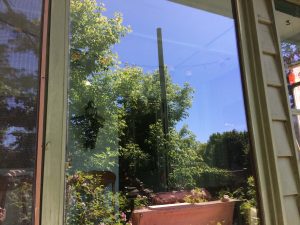 We’ve all heard it: the unmistakable thump of a bird smashing into a closed window. We rush outside to assess the situation. With luck, there’s either no bird there or it’s resting on the ground, panting and dazed, and flies away in a few minutes. Sometimes, the little one’s not so lucky.
We’ve all heard it: the unmistakable thump of a bird smashing into a closed window. We rush outside to assess the situation. With luck, there’s either no bird there or it’s resting on the ground, panting and dazed, and flies away in a few minutes. Sometimes, the little one’s not so lucky.
Window strikes are common and sad. Here’s why they happen, and what you do to prevent them.
Why do window strikes happen?
There are at least two reasons birds fly into windows.
Perhaps the more common is that the reflections of the sky, trees, and clouds in the window are so clear that birds don’t see the window in their path and think they’re flying into a continued airspace. This is a single strike, and if the bird is flying fast, it can hit hard enough to break its neck and die.
Less common is when a bird sees its reflection in the window and thinks it’s another bird in its territory. The bird attacks its reflection to drive its competitor away. This behaviour is particularly common in Northern Cardinals (who sometimes also attack car rear view mirrors!). This means repeated strikes that can happen dozens or hundreds of times a day and last for days or weeks.
Avoiding window strikes
Because both types of window strike are due to reflections in the window, the idea is to make the window more or, ironically, less, visible. There are several ways you can do this:
Make the window more visible, break up the clear line of sight, or distract birds from it.
- Don’t clean windows that have large open spaces outside of them during your spring cleaning (Yay!).
- Buy window crayons and let the kids go at it. These can become beautifully colourful temporary decorations. No kids? Consider it an opportunity to express yourself!
- Install awnings or exterior screens.
- Put something outside near the window… flag pole, clothesline, tall potted plant, umbrella-style clothes drying rack
- Enhance/create an outdoor living space by building a pergola close to the window.
- If you have a bird feeder, put it close to a window. Many birds will focus on and fly to it, and when they fly away from it, they can’t get enough speed to injure themselves if they do hit the window.
A common variation on this approach is to make birds think there’s a predator there.
- Window decals: the classic black silhouette seen in windows is that of a bird-eating falcon, which birds recognize as a threat and avoid. If you don’t want such an obvious sticker on your windows, you can buy almost-transparent decals that are visible under UV light. Birds can see in the UV spectrum, so there decals are far more visible to birds than they are to us.
- Have a housecat? Create a space just inside the window that your cat will love to hang out on. Set up a cat pillow, blanket, or towel to invite your cat to spend time at the window. (Note: Outdoor cats kill thousands of birds a day in North America. If you have a feeder in your yard, please keep your cat indoors.)
Make the window “disappear”.
- Keep windows open with mesh screens closed so birds see into your house but can’t get in.
- Plant shrubs close to ground-floor windows that will grow tall enough to hide the window.
- Install shutters and close them. Like curtains, they can keep your house cool during the summer.
We hope these tips help you reduce the number of bird window strikes, so you can enjoy their company at your feeder and in your garden. The Avant-Garden Shop carries several products that can help reduce window strikes.
We’ve discussed this topic in two of our Garden Gate Episodes on CHEX TV:
- Episode 89: A conversation with Michael Measure from FLAP (Fatal Light Awareness Program)
- Episode 135: Birds striking and flying at windows
